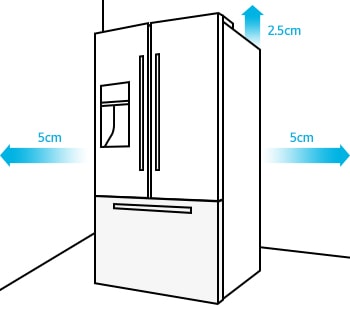What to do when the refrigerator makes noise
Most noises that may sound unusual coming from the refrigerator are normal during its operation. Please check the list below to see which of the noises from the refrigerator are normal or not and find out how to prevent abnormal noise.
Normal noise and causes
- Compressor noise
|
Tone |
Cycle |
Cause |
|---|---|---|
|
Hmm~~ |
10 sec. ↓ |
When operating a refrigerator, it is the noise that occurs when a stopping compressor increases its RPM quickly. (E.g. a case similar to the engine noise when starting a car.) |
|
Hmm~ high pitched |
2 min. ↓ |
The noise generated by automatically changing to the RPM of the compressor according to the operating condition. (set temperature, inside/outside temperature/humidity, etc.) (E.g. similar to engine fluctuation noise when a car's speed changes.) |
|
Hmm~ high pitched |
1 day ↓ (Initial installation) |
During the first operation of the refrigerator, the compressor or fan rotates at a high speed to lower the temperature in the refrigerator quickly, and a relatively loud noise appears. (E.g. when the car is running at high speed, the engine noise is loud.) |
|
Clicking |
Continuously |
This is the basic operation noise when the compressor internal parts open and close. - The tone changes according to the compressor rotation speed. |
|
Pitter patter~ |
10 sec. ↓ (When the compressor is off) |
The noise that occurs when the compressor stops spinning at high speed. - It is similar to front-leaning when the brake is pressed. |
- Fan motor noise
|
Tone |
Cycle |
Cause |
|---|---|---|
|
Hmm~ high pitched |
10 sec. ↓ |
When operating a refrigerator, it is the noise that occurs when a stopping compressor increases the RPM quickly. |
|
Hmm~, beep~ |
Continuously |
Wind noise generated by the fan motor rotating. - There is a change of rotation speed depending on the operating conditions (set temperature, inside/outside temperature/humidity, etc.) and the noise changes. |
- Cycle (Pipe) noise
|
Tone |
Cycle |
Cause |
|---|---|---|
|
Prrrrrr~ Rip~ |
Continuously |
The noise of the refrigerant spray. - The noise generated when a refrigerant is injected into a large pipe from a microtubule. (refrigerator basic cooling principle) |
- Cycle (evaporator) noise
|
Tone |
Cycle |
Cause |
|---|---|---|
|
Growl~, shoo~boiling |
Continuously |
The noise generated by the refrigerant flowing through the pipes in every corner of the refrigerator. - The same principle as the noise of water flowing in the water supply/drainage pipe at home. |
- Other noise
|
Tone |
Cycle |
Cause |
|---|---|---|
|
Pop!, snap! Rattle! |
1 sec. ↓ (momentary ) |
When the temperature inside the refrigerator is changed, it is the noise generated by the internal compressor as it expands and shrinks. (E.g. similar to the noise of the car hood such as ting! when the car is turned off.) |
- Evaporator noise
|
Tone |
Cycle |
Cause |
|---|---|---|
|
Clitter~ |
3 min. ↓ (When defrosting) |
It is the noise wherein the frost melt falls when defrosting the cooler. - Cooling performance is improved when frost is removed. |
|
Ting!, ting! |
30 min. ↓ (When defrosting) |
It is a noise generated when the frost is defrosted by the internal heater. (E.g. the noise of cold dripping water in hot pans.) |
- Drain hose noise
|
Tone |
Cycle |
Cause |
|---|---|---|
|
Swish~ |
Door Open/Close |
The noise of wind blowing to defrost the water hose. - When the refrigerator door is opened and closed, the air flows out to/from the refrigerator. (To improve the door opening force) (E.g. a room door closes easier if a window is open. Wind noises occur between the windows.) |
How to prevent noise
- Make sure the refrigerator is level.
- Level the front legs of your refrigerator, at an incline of plus or minus 10 to 15 degrees; the refrigerator should be tilted back. To turn the legs, you can use a flat blade screwdriver on a leg nut. Turn it clockwise, or counterclockwise.

- Tighten the hinge.
- If you have moved the refrigerator door, the nuts or screws of the hinge may be loose.
- Leave enough space between the refrigerator and wall.
- It is recommended that there is at least 5 cm between the back of the refrigerator and the wall.

- Leave enough space in the refrigerator.
- Check that the glass containers placed on the shelves do not vibrate.
- Check to see if there are objects that have fallen under or behind the refrigerator.
- Wait for 24 hours.
- When you've checked off all of the steps above, leave the refrigerator for at least 24 hours. If the noise doesn't stop after 24 hours, please contact the Samsung service center.
Thank you for your feedback!
Please answer all questions.



